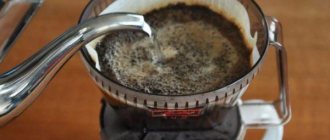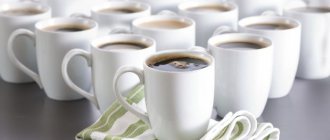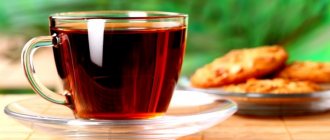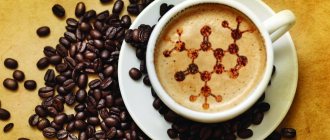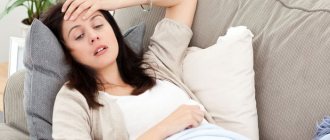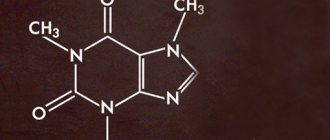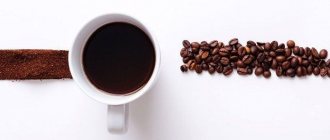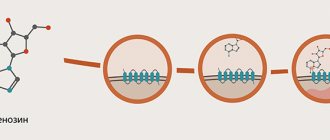© rosinka79 — stock.adobe.com
Share:
Pure caffeine is synthesized in tea leaves (approximately 2%) and coffee tree seeds (1 to 2%), as well as in small amounts in kola nuts.
According to its chemical characteristics, caffeine is a white crystalline powder, odorless, with a bitter taste. Dissolves quickly in hot water, slowly in cold water.
In a chemical laboratory, scientists developed a synthetic analogue of caffeine with the formula C8H10N4O2 and began to widely use it in the food industry, for example, for the production of energy soft drinks, which are very popular among young people. But it should be noted that with prolonged use, sensitivity to the component decreases, the body gets used to it and begins to require an increase in dose. Therefore, you should not abuse such drinks.
The main property of caffeine is to have a stimulating effect on the central nervous system, due to which drowsiness and fatigue disappear, new strength and energy appear.
Safe dose of caffeine
The permissible amount of coffee depends not on the number of cups of this drink, but on the proportion of caffeine content. After all, each person has his own preferences: some drink strong espresso, while others drink Americano diluted with water.
Doctors say that at one time the drink should not enter the human body more than 100-200 milligrams of caffeine in its pure form. This is two teaspoons of instant powder or three teaspoons of natural ground grains.
The safe daily dose of caffeine for an adult is 300 milligrams or three cups of the finished drink. It is in this quantity that it will not cause harm to health, will help overcome fatigue, charge the body with energy and increase endurance when playing sports.
Attention! Elderly people are advised to reduce the dose of coffee consumed per day or, if necessary, completely eliminate it from the diet (depending on their health status).
How much caffeine is in sweets and drinks?
- Various types of cola contain from 15 to 20 mg of caffeine per 100 g.
- A standard can of energy drink (230g) delivers between 70 and 300mg of caffeine. When purchasing this drink, be sure to study the composition - the manufacturer must indicate the caffeine content in their product.
- A 200g cup of cocoa contains about 20mg of caffeine.
- A piece of dark chocolate weighing about 30 g - 20 mg of caffeine.
- A piece of milk chocolate weighing about 20 g contains six mg of caffeine.
- White chocolate does not contain caffeine.
What are the dangers of drinking too much of a tonic drink?
Daily consumption of caffeine in amounts of more than 300 milligrams provokes a nervous and anxious state, the so-called caffeine agitation. The person becomes irritable and often suffers from insomnia. In some cases, digestive problems occur.
In addition, caffeine has a diuretic effect. If it enters the human body in increased quantities, it can lead to dehydration. However, studies have shown that drinking too much of the drink usually does not increase the need for additional fluid. This is explained by the fact that the human body gradually adapts and adapts to it.
Effect on the body
Caffeine is a stimulant of the central nervous system, activating the brain, motor function, increasing endurance, performance, and reaction speed. Taking the substance leads to increased breathing, heart rate, increased blood pressure, dilation of the bronchi, blood vessels, and bile ducts.
Caffeine has the following effects on the body:
- Activates brain function.
- Reduces fatigue.
- Increases performance (mental and physical).
- Accelerates heart contractions.
- Increases blood pressure.
- Stimulates the functioning of the gastrointestinal tract.
- Speeds up metabolism.
- Has a diuretic effect.
- Increases breathing speed.
- Dilates blood vessels.
- Stimulates the liver to produce additional sugar.
How to reduce the amount of caffeine?
Another way to reduce the dose of caffeine consumed is to reduce the amount of caffeine in the drink. The content of this substance varies depending on the type of coffee. For example, in Arabica it is 30% less than in Robusta.
The amount of caffeine in a cup of coffee may also vary depending on the degree of roasting of the beans or the brewing method.
It is recommended to resort to some tricks when brewing. To ensure that as little caffeine as possible gets into the drink, it is recommended to reduce its preparation time to a minimum. To do this, the ground grains are poured not with cold, but with hot water (preferably boiling water). Then the drink should be brought to a boil and immediately removed from the heat, after which all that remains is to strain it and pour into cups.
Attention! The absorption of caffeine by the human body depends on the presence of sugar, milk and other ingredients in the drink. For example, espresso contains a small amount of water, so it is digested faster than a latte, an Americano with milk or a cappuccino. Therefore, the negative effect of this drink on the body will be more aggressive.
What determines the caffeine content in coffee?
Type of coffee.
Robusta coffee, which is used in instant coffees, contains twice as much caffeine as Arabica coffee, the most common type of coffee bean on the world market.
Thus, a cup of Robusta espresso with a volume of about 170 g contains up to 200 mg of caffeine. A similar cup of Arabica contains about 110 mg. Roasting.
Many people believe that dark roast coffee is stronger because it has a more pronounced taste and aroma.
However, heavily roasted beans contain less caffeine because prolonged processing at high temperatures breaks down the caffeine molecules. Grinding
Different methods of preparing coffee require different degrees of grinding of the coffee beans.
For example, to make Turkish coffee you need to grind the coffee almost into dust, but for a drip coffee maker or press the coffee is ground quite coarsely. Please note that the finer the coffee grind, the more caffeine will be in the finished product, since the substances contained in small particles are more easily washed out with water. Cooking time.
The longer the coffee is brewed, the higher the caffeine level it will contain. For example, coffee from a press brewed over a long period of time contains more caffeine than coffee brewed instantly using ristretto steam.
Which powder to choose: ground or instant?
The most useful is ground coffee. Soluble is inferior to it in terms of taste and strength of aroma, and most importantly - in terms of usefulness. Its composition is devoid of many substances found in coffee beans. All that remains after processing the raw materials is pure caffeine.
Today on store shelves you can see coffee without this substance. But such a drink is not as safe as it seems. Removing caffeine is impossible without the use of natural solvents, which, when released into an already brewed drink, form chemical compounds hazardous to health. Some of them can cause cancer of the human digestive system.
Therefore, doctors recommend reducing caffeine levels in other ways. Otherwise, it is better to completely avoid drinking the tonic drink.
What determines the caffeine content in tea?
There is no caffeine-free tea.
Coffee can be completely freed from this substance.
However, any type of real tea, both black and green, will contain caffeine. Type of tea.
Varieties of teas vary in caffeine content. Black teas contain the most of this substance: a 200 g cup contains from 60 to 85 mg of caffeine. White teas confidently occupy second place: a cup of the same volume contains up to 75 mg of this substance. A cup of regular green tea contains 30 to 60 mg of caffeine.
Principles of proper coffee drinking
Drinking coffee, even in acceptable quantities, can be harmful if you do not adhere to the following rules:
- Do not consume on an empty stomach. It is recommended to drink a cup of coffee immediately after eating or after 1–1.5 hours.
- Prefer a drink made from freshly ground grains to the detriment of instant.
- Stick to the established consumption limit, namely three cups per day. Never drink more than six cups per day, as this may lead to decreased sensitivity to the effects of caffeine.
- Do not drink later than four to five hours before bedtime. Otherwise, insomnia may occur, which will interfere with proper rest.
Dmitry Petelin: “The norm for caffeine consumption is no more than 400 milligrams per day”
Emotional disorders and panic attacks are now talked about openly and without shame: girlfriends honestly talk about the last time they went to a psychotherapist and what antidepressants they were prescribed. All networks write about how important it is, first of all, to monitor your emotional state, because if everything is not okay with it, then often health problems are added to this. I have never been one of the depressed people - I always quickly switched after some failures and did not concentrate on failures. Of course, there were sadder times and happier ones, but overall my life has always been stable - as has my mood. But in the last couple of months everything has changed.
Emotional rollercoaster
Even valerian and afobazole, eaten in one gulp, did not calm nervous shortness of breath in the office - previously they always helped out at the most critical moments. The emotional background has turned into a roller coaster: one hour I am very active, the next I don’t want to do anything and mindlessly wander through links on the Internet. The closer the end of the day is, the faster these slides change the amplitude of rise and fall and at the end line up in a straight line - an extremely unpleasant nervous state when you want to cry from literally everything. Someone unsuccessfully placed a cart in front of you in the store, blocking the path to the refrigerator - hysterical. The taxi driver took a route that was not his favorite - a tragedy. The notifications on the phone are noisy again - information garbage. For almost a month I got home, lay down on the bed and didn’t get up: my brain was bursting with the number of plans I wanted to implement, but in the end I couldn’t choose one thing and waited until the nervous overstrain relieved me. At the same time, it cannot be said that there were more tasks at work or that there was a stressful period - in general, nothing changed. But when I left the office, I almost always wanted to cry. Just like that and for no reason. As a moderately experienced beauty editor who has read and written more than one thousand texts about self-care - including taking care of your emotional state - I began to look for a problem in my lifestyle. And I found it - in a cup of coffee.
You may be surprised and think that this is just my fantasy: everyone drinks coffee all the time, and if this were really the reason, my emotional problems would have started much earlier. But the thing is, until this summer, I had never drank more than one cup a month. In our family, it was not customary to start the morning with coffee - most often it simply wasn’t available in the house. I learned that many people are addicted to this drink when I was already an adult. The urge to repeat after others did not appear then - I never really liked the taste of strong coffee. And in general, it made me nauseous more often than it invigorated me. However, office work from nine to six made its own adjustments. I resisted for a very long time, but by the end of May I noticed that thanks to a cup of coffee after lunch, it was much easier to give up snacks and “birthday” pizza, which appears on our editorial table with enviable regularity.
Thanks to coffee, my body dried out: the fat that I didn’t really like was partially gone. So a cup of drink after lunch turned into a ritual - it gave me energy and helped me survive until dinner without an afternoon snack. Slowly, I got hooked on coffee—my mornings began to start with it. On particularly difficult days, I drank three cups. Baby talk, you say. But it turned out that such a dose for my height of 153 centimeters was quite enough to make me go a little crazy.
Why did I start looking for the problem in caffeine?
I guessed that the problem lay in the coffee - there have been no other strong changes in my life recently. But I was encouraged to try not just to reduce the dose, but to completely give up this drink, because of the result of the genetic test that I took at Atlas when preparing one of our materials. It clearly stated: my body is slowly eliminating caffeine. This means that several cups drunk in one day work with double force. For those who like theoretical descriptions, I will clarify that I have the CYP1A2 gene, which reduces the activity of cytochrome, as a result of which caffeine remains in the body longer and provokes unwanted side effects. Moreover, the problem lay precisely in the coffee—tea did not cause such emotional states. This is because tea contains tannins, which make caffeine less absorbable and less effective. What scientific research says.
If not caffeine completely, then at least it was decided to do away with coffee. And of course, first of all, I started reading various studies about the relationship between caffeine and our emotional state. The results of the hunt for information turned out to be very interesting. Cambridge concluded back in 2005 that caffeine can aggravate nervous conditions, and its excessive consumption causes symptoms very similar to many serious mental disorders. However, most doctors don’t even ask whether you drink coffee or not when they make serious diagnoses. Of course, caffeine does not have this effect on everyone: if you have problems with your emotional state, you may be at risk.
People with panic disorders and social phobia are especially sensitive to this substance; caffeine can cause panic attacks in them. “In my practice, the issue of the amount of coffee is discussed with almost every patient, since for many diseases its consumption needs to be reduced. This is an exacerbation of gastritis, peptic ulcer, heartburn. But still, even in such cases, we allow up to two cups a day,” says Elena Volodkina, a gastroenterologist and nutritionist at the Aging Control clinic. “Caffeine stimulates the nervous system, and if a patient has a predisposition to irritability, is tense and anxious, then caffeine may have a negative effect on them and worsen these symptoms.”
In order to fully understand this issue and not be unfounded, I talked with a psychiatrist at the First Moscow State Medical University. I. M. Sechenov Dmitry Sergeevich Petelin.
Not quite the standard perception of caffeine - a disease?
“On the territory of the Russian Federation, as in most countries of the world, the so-called international classification of diseases, tenth revision, is used. It lists all existing diseases and conditions that can be diagnosed to a person at an appointment. This list includes a section on “mental and behavioral disorders associated with coffee consumption.” True, there it is not highlighted separately, but is listed along with other stimulants - drugs that invigorate or increase the level of activity. That is, in theory such a diagnosis exists, but in practice it is made quite rarely. It must be emphasized that under this “heading” there is a whole range of conditions that can be identified. Among them are acute intoxication with large amounts of coffee, dependence on drinking the drink, and so on.”
What is the daily caffeine intake?
“There is a recommendation of 400 milligrams. This is equivalent to about five standard espressos, two half-liter cans of energy drinks, about two and a half Starbucks coffee drinks, or ten 0.33-milliliter cans of Coca-Cola. It should be immediately added that many people prefer to drink coffee that they brew themselves or instant coffee.
This makes it difficult to measure how much caffeine is in each cup.” Is it possible to speed up the elimination of caffeine by the body?
"More likely no than yes. The fact is that caffeine is processed in the liver by a set of compounds that do not have any biological activity, and is then excreted by the kidneys. The weakening of the effect of caffeine depends on the speed at which the liver processes it; accelerating this process is problematic. As a rule, within four to five hours the concentration of caffeine in the blood is reduced by half. At the same time, the duration of caffeine processing depends on many factors acting on the liver. It may vary from one person to another on different days. For example, if a person smokes and has consumed a large amount of nicotine during the day, then the liver’s ability to process caffeine increases and, accordingly, it will be eliminated from the body faster, which will not be observed after a few days. But in no way am I advocating smoking to speed up the processing of caffeine.”
Is there a connection between mental disorders and caffeine consumption?
“There is a connection between caffeine and mental disorders. For example, such a well-known disease as schizophrenia can be divided into positive and negative. Positive symptoms are psychosis, hallucinations (when a person hears something that is not there, he has delusional ideas that someone is stalking him). Negative symptoms - emotional isolation, intellectual impairment. Caffeine, as a mild, mild stimulant, can affect both symptoms. That is, in some situations, in predisposed people, taking large amounts of caffeine can unmask positive symptoms. The person was already preparing for the onset of schizophrenia, he had such a genetic risk, everything came together, and against the background of a large amount of coffee, the nervous system was further stimulated - a response occurred in the form of psychosis. It’s incorrect to say that caffeine caused the disease, but it did provoke it.”
Does this mean everyone should give up coffee?
“In all such situations, the problem is not coffee, not caffeine, but primarily the human condition. If he is experiencing emotional stress, then caffeine can increase unpleasant symptoms. And indeed, there are people for whom, for medical reasons, drinking large quantities of coffee or drinking coffee at all may not be recommended due to health risks. This is not applicable to practically healthy people. Let's just say that severe anxiety while drinking coffee may indicate the presence of an early undiagnosed anxiety disorder. But only a doctor can figure out each specific case based on a detailed examination. It is impossible to give general recommendations for such a person.”
Who needs to drink less coffee?
After talking with doctors and studying literature on the topic, I came to the conclusion that coffee is not the best drink for those who work in stressful areas. So, if you notice that your life is difficult, try replacing the life-giving liquid from the coffee maker with something else. Fortunately, there are many alternatives now: turmeric latte, Japanese matcha, chicory, cocoa. They all invigorate a little and relieve hunger. And don't expect miracles: if you sleep for four hours, not a single drink will fill you with energy.
Publication link: Vogue
Restrictions for pregnant women and children
Women who are expecting a child should be especially careful about drinking coffee. Studies have shown that drinking more than four cups during the day can lead to fetal death. This is also fraught with disturbances in the development of the baby after his birth.
A safe dose is considered to be 100 milligrams of caffeine per day. In this case, it is necessary to take into account the doctor’s recommendations and indicators of the woman’s general health, her age, activity level and diet.
Attention! During pregnancy, it is not recommended to drink coffee if the woman’s menu includes products containing caffeine, as well as with high blood pressure and toxicosis. To replenish calcium in the body, milk should be added.
Children can drink a tonic drink from the age of 14. The permissible number of cups drunk is one or two per day. It is recommended to add milk or cream. After drinking the drink, you should monitor the teenager’s condition. If adverse effects occur, you should completely stop drinking coffee or reduce the number of servings.
